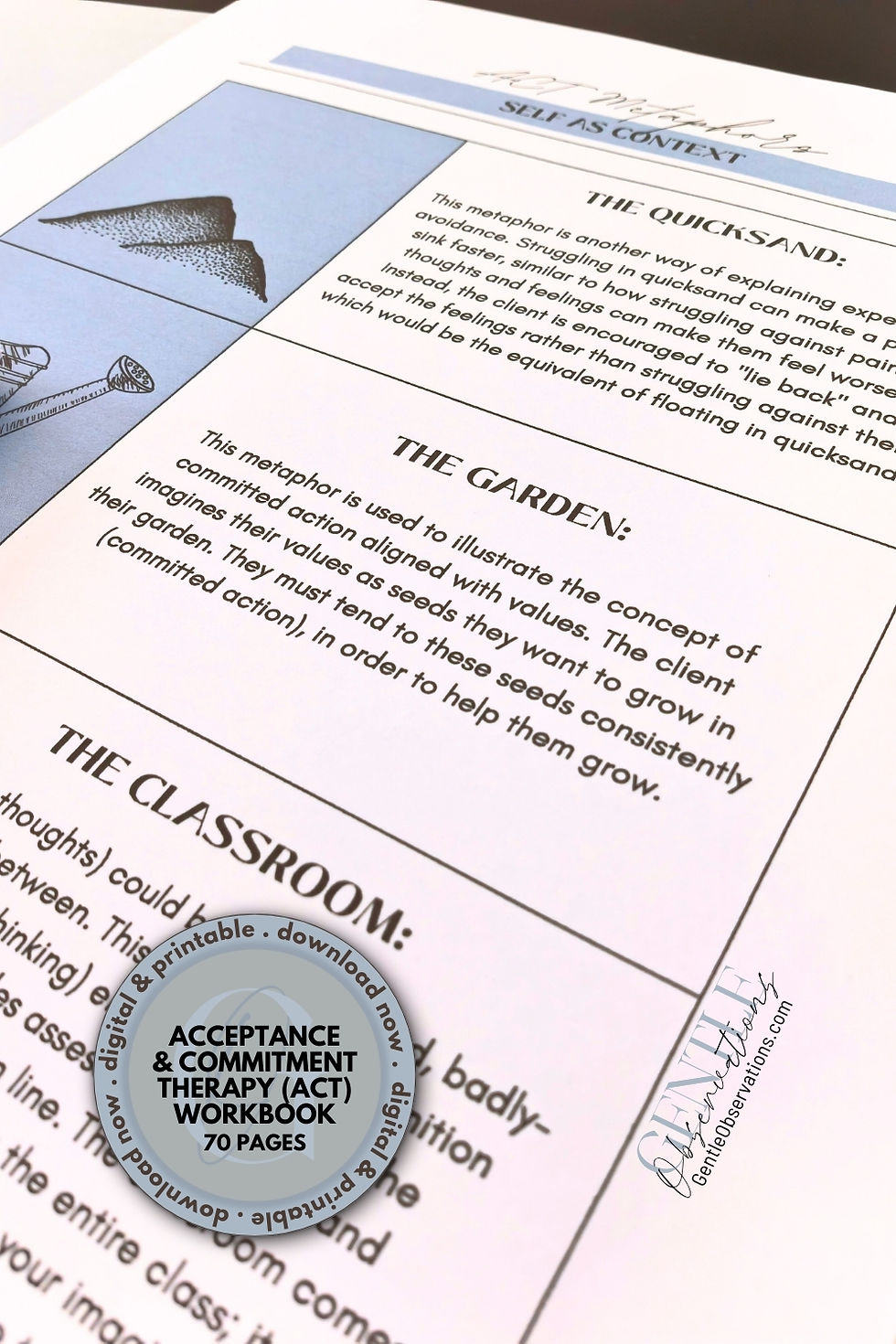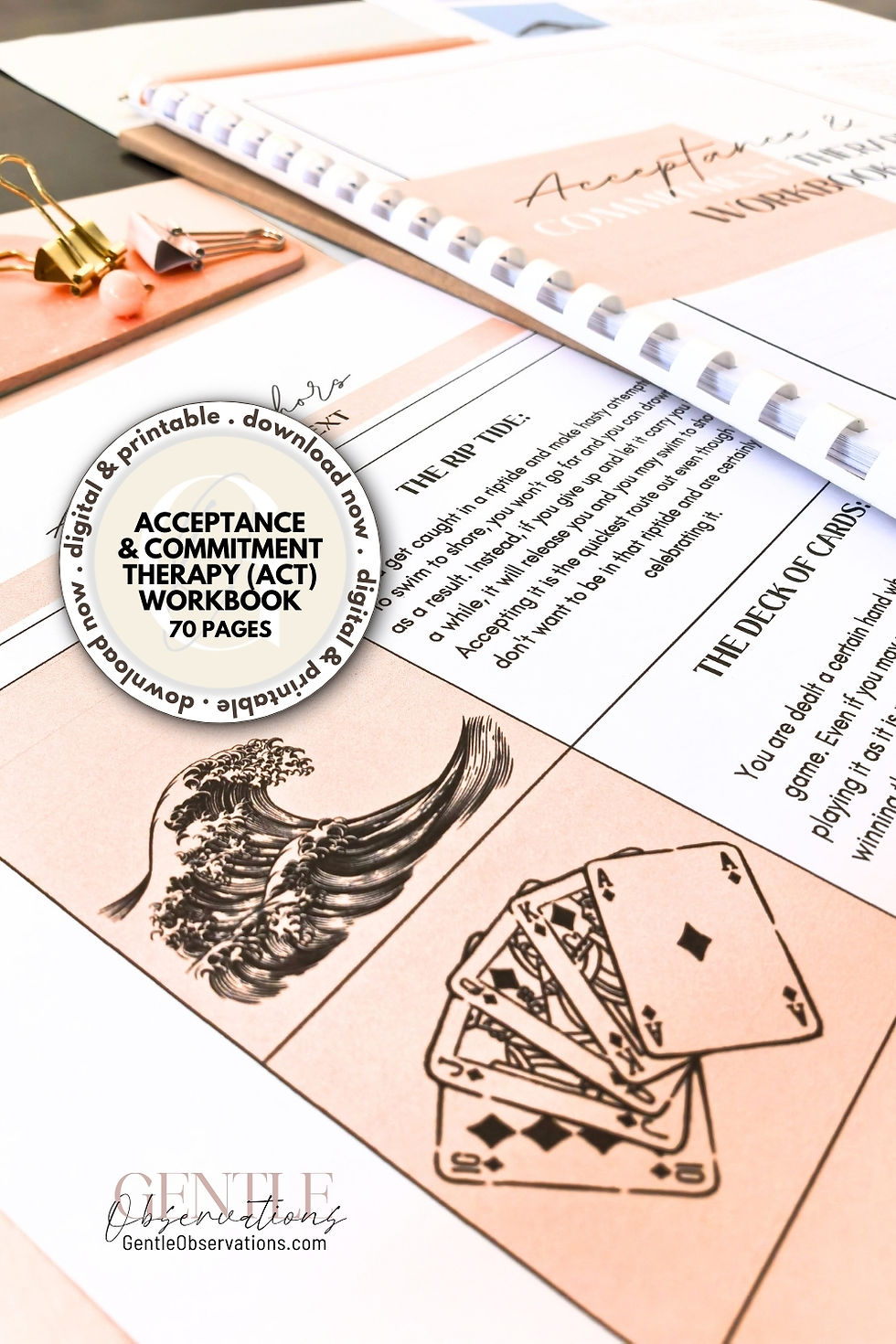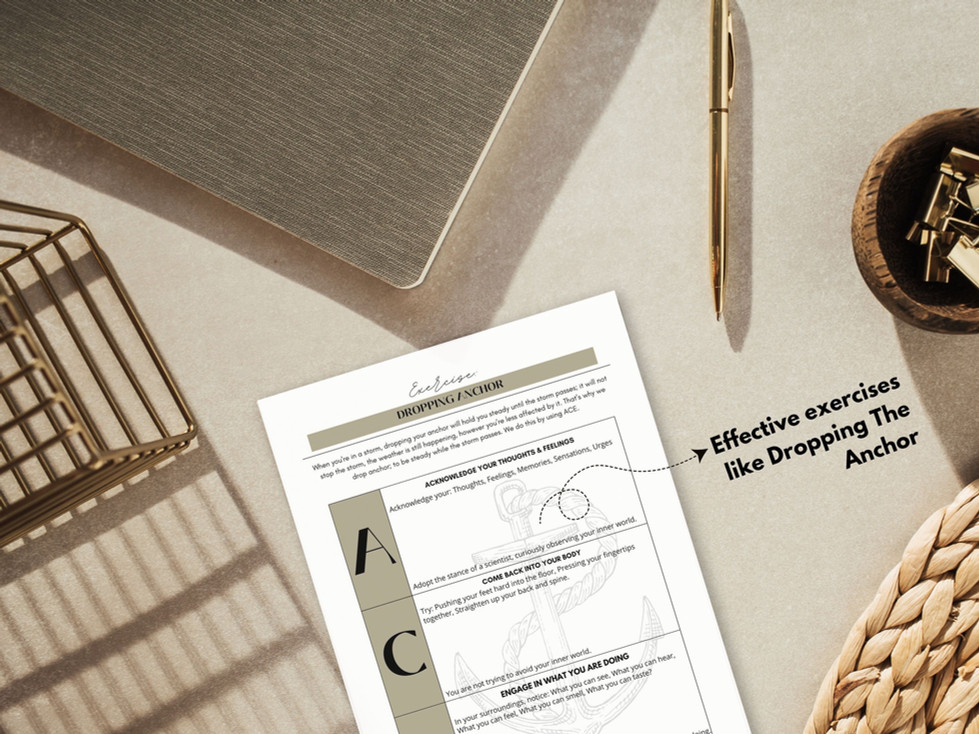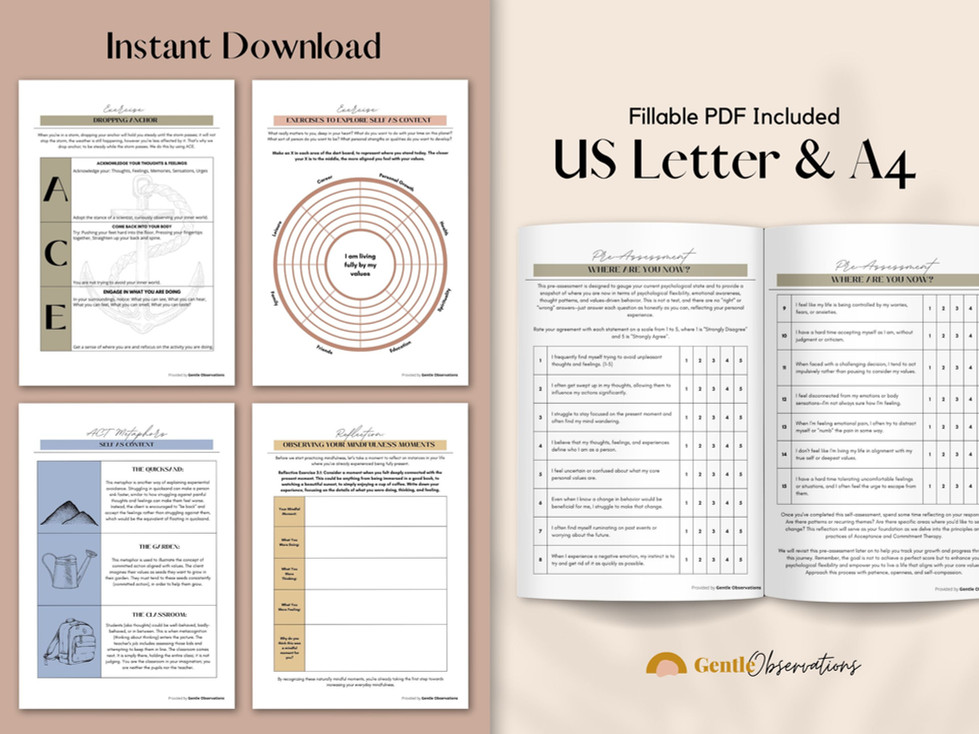Why Avoiding Your Emotions Isn’t Working-and What ACT Suggests Instead
- Monique McNamara
- Sep 7, 2025
- 9 min read
If you've ever caught yourself thinking, "I just need to stop feeling this way," you're not alone.
Most of us learned somewhere along the way that uncomfortable emotions should be fixed, avoided, or pushed aside. And when that doesn't work, when the anxiety is still buzzing, or the sadness won't lift, it's easy to feel stuck or even like you're doing something wrong.
But here's the thing: your emotions aren't problems to be solved. They're messengers.
And trying to silence them often adds more suffering, not less.
Acceptance and Commitment Therapy (ACT) takes a different approach. Instead of trying to get rid of painful thoughts or feelings, it helps you build a new relationship with them. One where you can notice what's showing up inside of you without letting it control you.
Imagine you're dreading a difficult conversation. Your instinct might be to distract yourself, pretend it doesn't bother you, or scroll through your phone just to feel something else.
But what if you could acknowledge the fear and still take a step toward the conversation because it matters to you? That's what ACT can help with.
If you've been pushing yourself to feel better, maybe it's time to try something that helps you feel more free instead.
What ACT Can Teach You About Handling Tough Thoughts and Feelings
ACT is built around six core processes that help you build what's called psychological flexibility. That's just a fancy way of saying you get better at handling tough emotions and thoughts, while still moving toward the kind of life you want to live.
Each process brings something different to the table. Together, they form a strong foundation for meaningful change.
If you're looking for more ways to use ACT practically, you might also enjoy our blog on real-life interventions and examples: ACT in Action: Practical Tips for Implementing Acceptance and Commitment Therapy.
Here's how each one works in real life:
Acceptance
Rather than pushing painful feelings away or pretending they're not there, ACT encourages you to acknowledge them gently.
Acceptance doesn't mean you like what you're feeling; it just means you're allowing it to be there, without a fight. This process can help reduce the extra suffering that comes from resistance.
Cognitive Defusion
Cognitive defusion is about changing the way you relate to your thoughts. Instead of getting tangled up in them, you learn to take a step back and see them for what they are: just thoughts.
This can be as simple as repeating a thought out loud until it loses its intensity, or labeling it by saying, "I'm having the thought that..." It creates distance and lets you decide how much power a thought should have.
Being Present
This is ACT's version of mindfulness, but without the pressure to clear your mind or sit cross-legged. Being present means noticing what's happening right now, inside you and around you, with openness.
Whether you're savoring a quiet moment or feeling overwhelmed, staying present helps you respond with more clarity and less reactivity.
Self as Context
This process helps you connect with a part of yourself that's steady, even when your thoughts and emotions are swirling. It's often explained using metaphors like "you are the sky, and your thoughts are the weather."
By noticing there's a part of you that can observe your experience without getting caught in it, you create a sense of groundedness and perspective.
Values
ACT puts a big emphasis on helping you clarify what really matters to you. Values aren't about what others expect or what sounds good; they're about what feels meaningful to you, deep down.
Identifying your values helps you choose direction in your life, especially when things feel uncertain or hard.
Committed Action
This is where everything comes together. Committed action means taking small, meaningful steps that line up with your values. It's not about being fearless or getting it perfect; it's about being willing to move forward, even with discomfort.
Over time, these choices add up and shape a more fulfilling life.
These principles work together to help you create a more open and meaningful life. You don't have to master them all at once.
Even starting with one shift in how you relate to your thoughts can begin to open up new possibilities.
A Self-Guided Journey Through ACT: What Makes This Workbook Different
Sometimes it's not enough to read about an approach, especially when it comes to personal growth. You want something that can guide you through it, help you reflect, and offer a clear path forward.
That's exactly what the Acceptance & Commitment Therapy Workbook is here to support.
If you've ever found yourself learning about ACT and thinking, "This makes sense, but how do I actually do it?", this might be the step-by-step structure you've been looking for.
Instead of simply explaining concepts, the workbook invites you into them.
Each chapter includes:
• A clear and simple breakdown of the ACT principle in everyday language
• Reflective prompts that help you connect the ideas to your own experiences
• Guided exercises that walk you through what the principle looks like in real life
• Space to pause, notice, and try things out with no pressure to get it perfect
The workbook starts with a thoughtful pre-assessment, helping you get a feel for where you are. And it ends with a long-term reflection and planning section, so you're not left wondering, "What now?"
Rather than offering rules to follow, it helps you build your own process for showing up more fully to the life you want to live.
Who Is This Workbook For?
If you've ever felt overwhelmed by your thoughts or stuck in emotional patterns that don't seem to shift, this workbook might be for you. It's written with warmth and accessibility in mind; no therapy jargon or unrealistic expectations, just supportive guidance for your own self-paced exploration.
You might find it especially helpful if:
• You've read about ACT and want something practical to apply on your own
• You're looking for a structure to help you reflect and grow without pressure
• You value emotional growth, but want to move at your own pace
• You enjoy writing, self-reflection, or working with prompts and exercises
• You want a gentle way to reconnect with your values and make meaningful changes
Whether you're new to ACT or have been working with its ideas for a while, this workbook meets you where you are and invites you forward, one thoughtful page at a time.
A Look Inside: What You'll Work On in Each Chapter
Chapter 1: Exploring Acceptance
Learn how to make room for difficult thoughts and feelings, rather than trying to push them away. This chapter includes reflection prompts to uncover the messages you've internalized about emotions, followed by practical exercises like identifying your barriers to acceptance and practicing mindful allowing.
Example prompts: • When have I struggled to accept a difficult feeling • What do I tend to do when I feel overwhelmed emotionally • What beliefs do I hold about feeling certain emotions
Chapter 2: Cognitive Defusion
This chapter shows you how to change your relationship with unhelpful thoughts. You'll learn defusion techniques like labeling thoughts, visual metaphors, and gentle self-talk.
The exercises invite you to practice each technique with a recurring thought of your own, building flexibility in how you respond to your inner narrative.
Activities include: • Labeling your thoughts using "I'm having the thought that..." • Practicing visual defusion exercises like watching thoughts float away • Reflecting on how your responses shift as you unhook from thoughts
Chapter 3: Being Present
Simple, guided mindfulness practices help you ground yourself in the moment. Whether it's breathing, observation, or a mindful body scan, these tools support daily presence.
You'll also find journaling prompts that help you reflect on when you feel most connected to the here and now.
Example prompts: • What are three moments today when I felt grounded • What helped me stay present during a difficult situation • How does my body feel when I pause and focus on the now
Chapter 4: Self as Context
Through metaphors like the sky and the weather or the chessboard, you'll explore what it means to be the observer of your experience.
Reflection prompts ask you to recall moments when you've experienced distance from your thoughts, and the exercises guide you in cultivating this observer self in daily life.
Example prompts: • When have I noticed my thoughts without getting caught up in them • What does it feel like to observe my mind, rather than be directed by it • What metaphors resonate most with how I see myself
Chapter 5: Uncovering Your Values
You'll be guided through a process of identifying what truly matters to you across different areas of life. With values checklists, journaling questions, and a dartboard-style activity, this chapter helps you begin naming your direction, not just your destination.
Activities include: • Life domain reflection: What matters most in your relationships, career, health, and more • Identifying values-driven qualities you want to embody • Dartboard activity to visually map how aligned you feel in each area
Want to try the values work for yourself before diving into the full workbook?
You can grab pages 47–53 from the ACT Workbook, including the values identification worksheet and journaling prompts, completely free in the FREEBIE LIBRARY
Chapter 6: Committed Action
This is where reflection meets action. You'll explore what stands in your way and how to carry your values with you even when it's hard.
Activities include goal-mapping templates, SMART planning tools, and space to track the smallest first steps that matter to you.
Activities include: • Creating a values-based action plan • Identifying internal obstacles and practicing willingness • Breaking down goals into tiny, doable step
5 Tips to Get the Most Out of the Workbook
This isn't a workbook you need to rush through. In fact, it works best when you give yourself time to reflect, pause, and return to parts that resonate with you.
Here are a few tips to help you use it in a way that supports your unique journey:
Go at your own pace. Some people like to do one chapter a week, others may spend a month on one concept. Either way is okay.
Use a journal or notebook if you need more space. There's space in the workbook to write, but if you love to reflect in longer form, bring in your own tools.
Start where you feel pulled. While the workbook follows a helpful order, it's perfectly okay to jump to the chapter that feels most relevant to you right now.
Come back to it. This isn't a one-time experience. Many people revisit different chapters again and again as their insights evolve.
Be kind to yourself. The work can stir things up. Keep your expectations soft and your inner voice gentle.
There's no "right" way to work through this. Just your way. And that's exactly enough.
Ready to Begin? Start Your ACT Journey Here
If the ideas here have resonated with you, and you're ready to move from insight into action, the Acceptance and Commitment Therapy Workbook might be the next step.
It's filled with structured, supportive exercises that help you apply ACT principles in real-life, meaningful ways.
You can work through it at your own pace, pause and return when you need to, and use it as a tool for reflection, intention, and gentle change.
Whether this is your first step into ACT or you've been practicing for years, this workbook is here to meet you where you are.
Gentle Observation: It takes courage to slow down and consider your own growth, especially when life feels messy or overwhelming. My hope is that ACT offers you a way to move forward that feels grounded, kind, and true to you. Not perfect, not polished; just honest and real.
You don't need to have everything figured out to take the next step. And you don't have to go it alone.
This workbook, and this way of working with yourself, is here when you're ready.
Jemma Gentle Observations Team
P.S.
If you'd like more guidance on using ACT in your work or daily life, you might also enjoy this related post: ACT in Action: Practical Tips for Implementing Acceptance and Commitment Therapy.
P.P.S.
If you're a Therapy Resource Library member, you already have access to this workbook in your account. Just log in and download it whenever you're ready.
Not a member yet? You can learn more about the Therapy Resource Library and how it gives you access to dozens of tools just like this one, all designed to support meaningful, compassionate growth here.
P.P.P.S.
Want to try the FREEBIE out first? You can grab pages 47–53 from the ACT Workbook, including the values identification worksheet, completely free in the FREEBIE LIBRARY


























Comments